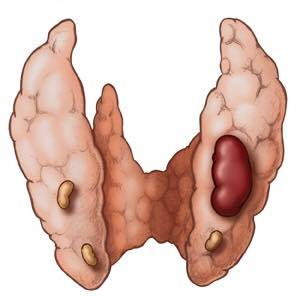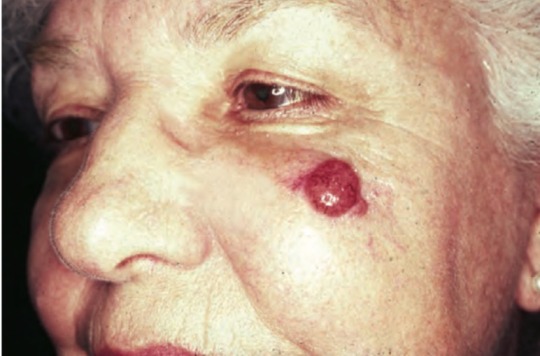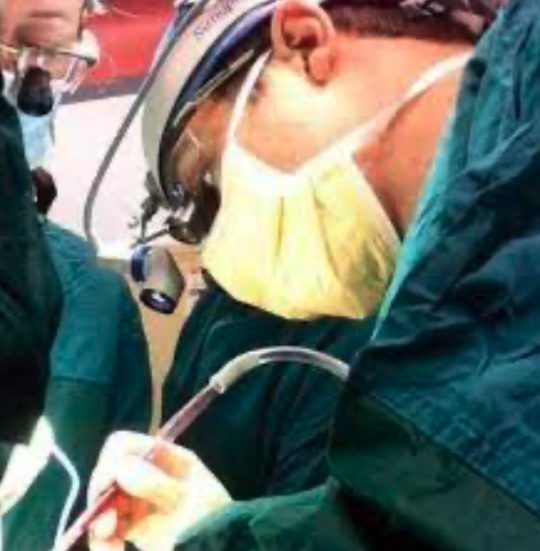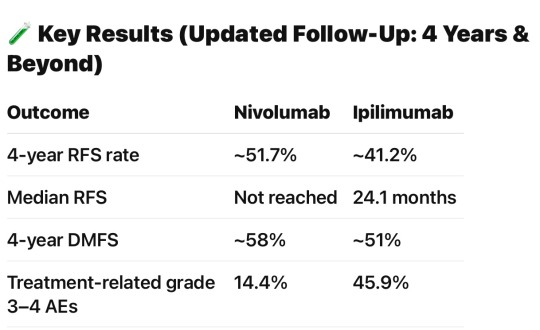Text
SOUND Trial – Journal Club Questions and Answers
What was the primary objective of the SOUND trial? Answer: To determine whether sentinel lymph node biopsy (SLNB) can be safely omitted in women with early-stage, clinically node-negative breast cancer with negative axillary ultrasound: No Without compromising distant disease-free survival. What does “SOUND” stand for in this trial? Answer: SOUND stands for: Sentinel node vs Observation…

View On WordPress
0 notes
Text
SOUND Trial Summary
Title: Axillary Surgery in Breast Cancer Patients With Negative Axillary Ultrasound: The SOUND Randomized Clinical Trial Published: 2023 in JAMA Oncology ClinicalTrials.gov ID: NCT02167490 Location: Italy (32 centers) Study Objective: To evaluate whether sentinel lymph node biopsy (SLNB): Can be safely omitted in women with early-stage, clinically node-negative breast cancer with…

View On WordPress
0 notes
Text
INSEMA Trial in Breast Cancer Journal Club Questions and Answers
What was the primary research question of the INSEMA trial? Answer: To determine whether sentinel lymph node biopsy (SLNB) can be safely omitted in patients with clinically node-negative early-stage breast cancer undergoing breast-conserving surgery and whole breast radiation, without compromising invasive disease-free survival (iDFS) What type of study was this, and how was it…

View On WordPress
0 notes
Text
INSEMA Trial In Breast Cancer
The INSEMA trial: Was a large, prospective, randomized, noninferiority study: Evaluating whether omission of sentinel lymph node biopsy (SLNB) is noninferior to SLNB in patients with: Clinically node-negative T1 or T2 invasive breast cancer undergoing breast-conserving surgery The trial enrolled over 5,500 patients: The majority of whom had small, hormone receptor–positive, HER2-negative…

View On WordPress
0 notes
Text
SOUND and INSEMA Trials for Omitting Sentinel Lymph Node Biopsy in Breast Cancer
Recent high-quality randomized trials have provided strong evidence supporting the: Omission of sentinel lymph node biopsy (SLNB) in select patients with: Early-stage, clinically node-negative breast cancer The SOUND and INSEMA trials both demonstrated that: In patients with small tumors (≤ 2 cm in SOUND; ≤ 5 cm in INSEMA) and negative axillary imaging: Omission of SLNB is noninferior to…

View On WordPress
0 notes
Text
Indications for Surgery in Hyperparathyroidism
All symptomatic patients and most asymptomatic patients should be considered for parathyroidectomy: Patients with nephrolithiasis (kidney stones), fragility fractures, osteoporosis, or evidence of spinal compression fractures are considered symptomatic. In asymptomatic patients (usually less than 5% of the cases when an appropriate history is taken), indications for parathyroidectomy…

View On WordPress
0 notes
Text
Dermatofibrosarcoma Protuberans
Dermatofibrosarcoma protuberans: Is an intermediate-grade sarcoma: That presents as a unifocal or multifocal nodular lesion It is a rare, slow-growing, locally aggressive cutaneous sarcoma: With a high rate of local recurrence and low metastatic potential Dermatofibrosarcoma protuberans: Involves the head and neck region in 10% to 20% of cases: With the scalp and supraclavicular fossae the…

View On WordPress
0 notes
Text
Merkel Cell Carcinoma
Merkel cell carcinoma Is a neuroendocrine neoplasm of theskin It is a rare, aggressive neuroendocrine skin cancer: With a high risk of local recurrence, nodal involvement, and distant metastasis The incidence is rising: Particularly among elderly and immunosuppressed patients, and prognosis remains poor, especially in those with advanced disease or immunosuppression A multidisciplinary…

View On WordPress
0 notes
Text
Targeted Therapy for Cutaneous Melanoma
Targeted BRAF and MEK dual inhibition (BRAFi /MEKi) in BRAF V600 mutant melanoma: Has been associated with relatively rapid response, high disease control rates, and a survival benefit in stage IV melanoma Unfortunately, this approach has also been associated with limited durability of response, leading some investigators to examine alternate stages of disease for this regimen Long et al.…

View On WordPress
0 notes
Text
Immune Checkpoint Blockade in Melanoma
Immune checkpoint blockade: Has fundamentally changed the management of cutaneous melanoma: Including in the adjuvant setting and for local recurrence after prior therapies These agents, primarily anti–PD-1 antibodies (pembrolizumab, nivolumab) and anti–CTLA-4 (ipilimumab): Work by releasing inhibitory signals on T cells: Thereby enhancing antitumor immunity This mechanism is particularly…

View On WordPress
0 notes
Text
KEYNOTE-716 Trial in Melanoma
The KEYNOTE-716 trial: Was a randomized, double-blind, phase 3 study: Evaluating adjuvant pembrolizumab (200 mg IV every 3 weeks for up to 1 year) versus placebo: In patients aged ≥ 12 years with completely resected, high-risk stage IIB or IIC cutaneous melanoma (T3b / T4, node-negative) The primary endpoint was: Recurrence-free survival (RFS) Secondary endpoints: Distant metastasis-free…

View On WordPress
0 notes
Text
EORTC 18071 Trial In Melanoma
The EORTC 18071 trial: Was a landmark, double-blind, phase 3 study that established the efficacy of adjuvant immune checkpoint blockade in cutaneous melanoma In this trial, patients with completely resected high-risk stage III melanoma were randomized to receive: High-dose ipilimumab (10 mg/kg IV every 3 weeks for 4 doses, then every 3 months for up to 3 years) or placebo The primary endpoint…

View On WordPress
0 notes
Text
Immune Checkpoint Blockade for Metastatic Melanoma
In a phase III, randomized prospective trial, Hodi et al: Evaluated 676 patients who received ipilimumab, ipilimumab plus a peptide vaccine, or peptide vaccine alone Overall response and disease control: Were highest in the ipilimumab alone cohort Median OS was: 10.1 months for this cohort and overall response was 10.9% Disease control was: 28.5%: With 60% of the ipilimumab cohort having…

View On WordPress
0 notes
Text
BRAF Inhibitors in Metastatic Melanoma
BRAF mutations: Have been found in approximately 50% of invasive cutaneous melanomas The BRAF gene: Encodes for production of B-RAF: A protein involved in cell signaling and growth BRIM-3: Was a randomized, open-label, multicenter, phase III study It compared a BRAF inhibitor, PLX4032 (vemurafenib), to dacarbazine: For treatment of previously untreated, unresectable, stage IIIC or stage…

View On WordPress
0 notes
Text
The KeyNote-054 (EORTC 1325-MG) Trial in Melanoma
The KEYNOTE-054 (EORTC 1325-MG) trial: Was a double-blind, randomized, phase 3 study: Evaluating adjuvant pembrolizumab (200 mg IV every 3 weeks for up to 1 year) versus placebo: In patients with completely resected, high-risk stage III cutaneous melanoma The trial demonstrated that adjuvant pembrolizumab: Significantly improved recurrence-free survival (RFS) compared to placebo: With a…

View On WordPress
0 notes
Text
CheckMate 238 Trial in Melanoma
The CheckMate 238 trial: Is a pivotal Phase III clinical study evaluating the efficacy of nivolumab (Opdivo) versus ipilimumab (Yervoy): As adjuvant therapy for patients with resected stage IIIB, IIIC, or IV melanoma The trial demonstrated that adjuvant nivolumab significantly improved recurrence-free survival compared to ipilimumab, with a more favorable safety profile This benefit was…

View On WordPress
0 notes
Text
Brain Metastasis in Cutaneous Melanoma
Melanoma ranks behind only small-cell carcinoma of the lung: As the most common tumor that metastasizes to the brain An unusual feature of brain metastases: Is their propensity for hemorrhage: Which occurs much more frequently with melanoma than other primary tumors Hemorrhage occurs in: 33% to 50% of patients with brain metastases from melanoma Prognosis worsens with an increasing number…

View On WordPress
0 notes